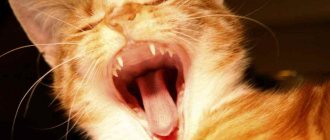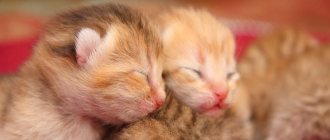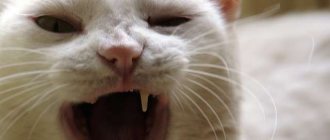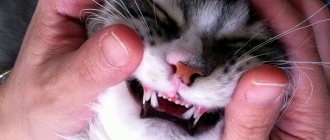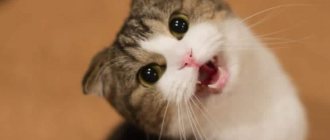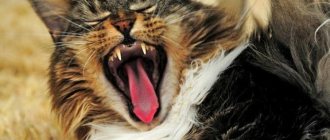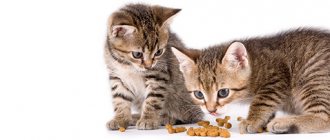Teeth for representatives of the cat family are a tool for obtaining food, protection, hunting, carrying kittens, and caring for their fur. Like humans, cats change teeth once in a lifetime, when the milk teeth fall out and in their place permanent teeth grow, with which the pet will have to live its entire adult life. The further healthy and comfortable existence of the animal depends on how the replacement process goes.
When kittens are teething: symptoms
You may not even notice when your pet's teeth change until you find the ones that have fallen out on the floor or in the basket where he sleeps. This is fine. Most kittens swallow their tiny teeth, but don't worry - it doesn't cause them any harm.
When a kitten's baby teeth change, you may notice the following changes in its behavior:
- Loss of appetite.
- Excessive desire to chew.
- Less frequent washing.
- Soreness and redness of the gums.
- Minor gum bleeding.
- Irritability.
At this stage, the kitten may also begin to scratch its mouth with its paw. If an owner notices this behavior, it may be due to a condition called deciduous teeth, explain experts at Tufts Catnip. However, some baby teeth just don’t want to fall out. This problem is rare, but it is worth paying attention to as the kitten may require tooth extraction.
Tufts emphasizes the importance of looking for signs of gingivitis or periodontal disease, such as severely swollen or bleeding gums and bad breath, when your kitten is teething. If your pet exhibits any of these symptoms, you should immediately contact your veterinarian to ensure your baby receives the necessary treatment.
Signs of changing baby teeth
In a healthy kitten, fangs, incisors and premolars fall out quickly and often do not cause him any discomfort. This occurs during play, eating dry food or solid food. Sometimes the first sign for its owner that a cat has lost a baby tooth is a thin fang found at home. But experienced owners will notice changes in the behavior of their little pet.
They are as follows:
- The kitten trembles with small tremors, looks for warm places, climbs into the arms or lap of the owner. This is due to a slight increase in the animal’s temperature during the period of tooth replacement. He feels the cold more strongly and tries to find a secluded, warm place.
- The pet is trying to chew everything.
- Regularly rubs his jaws with force with his front paws, trying to get rid of interfering teeth.
- While eating, he shakes his head and meows abruptly when hard particles fall on his swinging tooth. Sometimes the pet refuses food altogether. Don't be afraid, everything will pass in a couple of days.
These signs are a reason to examine your pet’s oral cavity to make sure whether the cat has baby teeth or whether they have already been replaced by permanent ones.
The kitten is teething: how to help him
Cutting sharp teeth through sensitive gums always causes physical discomfort, but according to Greencross Vets, it's usually minimal.
The kitten will try to reduce the pain and irritation associated with teething. He may even try to use his owner as a chewing toy, which the latter is unlikely to like. In this case, as during other aggressive cat games, you need to switch the kitten’s attention to something else.
One safe item to use as a chew toy is a cool, damp washcloth. You can chew on it as much as you like, and this will help reduce discomfort. Fabric toys and braided ropes are also suitable.
Alternatively, you can purchase kitten chew toys from a pet store, such as those made from nylon that are easy to chew or those that can be kept in the freezer. For the safety of the kitten, it is better for the owner to be nearby while he plays with these toys. In all cases, you should follow the manufacturer's instructions and check toys for integrity, immediately discarding damaged ones.
The kitten may try to chew furniture legs or wires. Such actions can not only lead to damage to things, but also cause harm to the pet. “To prevent accidental injury from destructive chewing, cover electrical cords and wires with protective plastic covers,” advise Your Cat. They also suggest placing double-sided tape on the areas you want to protect from your kitten's sharp teeth.
Caring for your cat's teeth
It is useful to sometimes look into the mouth of a domestic animal for a general assessment of the condition of the teeth and oral cavity as a whole, even if outwardly there is no hint of problems with the chewing apparatus. There are no special conditions for caring for a cat’s oral cavity, other than proper nutrition in accordance with age.
Advanced case of tartar in a cat
One of the most common problems with cat teeth is tartar. In nature, predators do not have this problem. Pets who receive dry food or food in large pieces do not have it either. With regular feeding of soft foods, when the procedure of self-cleaning of the oral cavity is excluded, plaque forms on the teeth, which under the influence of bacteria, salts and food debris turns into tartar. The launched process will require cleaning with special tools in veterinary clinics and under anesthesia.
The importance of good oral hygiene in kittens
Dental and gum disease is common in cats, but making an effort to maintain your kitten's oral health can help prevent future occurrences.
Regular dental care with exams and cleanings can reduce medical costs and prevent diseases such as gingivitis, periodontitis and tooth resorption. It is worth starting the procedure after teething has finished to avoid additional discomfort for the kitten. It is necessary to give the kitten food appropriate for its age - this will also alleviate the painful condition associated with teething.
The kitten may not tolerate this process well, so be sure to give him a lot of love, support and patience until all the new teeth are in place.
Features of teething and replacement of baby teeth
Kittens are born toothless. Baby teeth begin to emerge in the second week of life. They have a milky white color and a peculiar structure. Unlike permanent teeth, primary teeth are thin and very sharp, resembling needles. Only the primary canines are slightly curved; they have an additional tooth on the inside that falls out after they are replaced.
Normally, all baby teeth in cats should erupt by 6-8 weeks in a certain sequence. The first to appear in two-week-old kittens are the incisors, by 3-4 weeks the canines appear, and after 3-6 weeks the premolars (small molars). By the second month of life, there should be 6 pieces on both jaws, 2 canines, 4 small molars on the upper jaw, and 6 on the lower jaw (26 pieces in total). After replacing the molars, there are 30 of them, the set is replenished with four molars.
Each group of teeth performs a specific function:
- incisors are responsible for grasping;
- fangs tear food, help catch and hold prey;
- premolars and molars cut and grind hard food (bones, cartilage).
The absence of one or more incisors, premolars, or canines is a reason to contact a veterinarian. Perhaps the kitten has a pathology.
The age when baby teeth in cats begin to be replaced by permanent teeth is 3 months. The process lasts 12-16 weeks, but may be delayed due to the individual developmental characteristics of the kitten or its breed. For example, for Maine Coons, the shift lasts up to a year, because these large cats are considered kittens up to 15 months of age and their primary incisors, fangs, and molars fall out much later than in smaller breeds.
British cats
Is your kitten teething?
The birth of little fluffy balls is a joyful moment in the life of every breeder! But the birth of kittens is not only joy, but also certain responsibilities associated with caring for the growing offspring that fall on the shoulders of lovers of furry pets. For the first two weeks, newborn kittens do not cause any trouble to those around them, snoring peacefully, gaining strength for future adventures near their mother cat. By the end of the second week of life, the kittens’ eyes begin to open, and the hearing organ begins to work, and by the end of the third week, baby teeth begin to erupt , turning small fluffy balls into real “predators.”
And already at the age of 8 – 10 weeks, a kitten can have a full set of baby teeth.
The first, milk teeth usually appear in a kitten completely painlessly, and do not cause concern either to the kitten itself or to its owners, but, alas, they are not durable and already at three months of age the kitten begins to replace milk teeth with permanent ones.
There is no clear schedule for changing teeth in our furry pets, but usually by the age of seven months this process ends, and the cat has 30 permanent teeth in its mouth. [yandex1] The period of changing baby teeth to permanent ones often brings a lot of trouble to the owners of furry pets. When a kitten is cutting its permanent teeth, it experiences some discomfort associated with the need to constantly massage its gums, using for these purposes everything that comes in its way! In this case, your hands, pieces of furniture and your wardrobe, various wires (which is completely unsafe for your pet!) and other household items may be damaged. And if you notice that your kitten begins to behave this way, take appropriate action immediately!
To prevent your kitten from causing damage to your property while changing its teeth, purchase a special toy for it, which is specifically designed for this purpose and will be simply irreplaceable during the period when the kitten is teething! I can recommend purchasing a toy from the manufacturer “ Petstages” . The toys made by this company are quite exciting and are perfect for cats who love to chew their toys, and especially for kittens during the teething period.
Before giving the toy to your kitten, you can first freeze it; this will additionally soothe your pet’s inflamed gums. Petstages company is a manufacturer of innovative products for both pets and children, and all the company’s products are high quality and safe! The toys this company makes for pets are quite popular, and I'm sure you can easily purchase one of these at your local pet store teething
We have protected ourselves from damage to property while changing the kitten’s teeth, but we shouldn’t forget about the pet’s health! During the period when a kitten is teething, it, like any growing organism, simply needs vitamins. Buy a vitamin complex with a high calcium content for your “rodent” at the veterinary pharmacy, and your pet’s teeth will grow normal and healthy, like a real predator’s!
I recommend reading about this topic:
- House - scratching post
- Disposable dishes for cats
- Home healers
- Gift for a cat for the New Year
- Longhaired cats
Zemanta
When is medical attention required?
Diarrhea is dangerous due to dehydration
If an infant receives only breast milk, the normal amount of stool may vary. Even if the baby does this after every meal, there is nothing to worry about. But if the child is artificial, then he should walk no more than 2 times a day.
Babies who have reached the age of 6 months have stool about 3 times a day if they are still breastfed but are actively receiving complementary foods. If a baby has stool more than 2 times a day, then we can talk about diarrhea. There is a list of cases when you cannot delay with the help of doctors. These include the following:
- stool more often than 6 times;
- watery stool;
- fetid smell;
- green color of stool, the presence of a flaky mass of orange shades;
- red shades of stool, presence of blood;
- diarrhea is accompanied by an increase in temperature or regurgitation in the form of a fountain.
If loose stools have become a common occurrence, the child often spits up, and weight gain leaves much to be desired, a comprehensive examination is necessary. It is quite possible that there is a serious illness. First, the following tests are prescribed:
Main causes of diarrhea
Eating disorders can lead to diarrhea
There are several very common causes of diarrhea that cause loose stools. They are harmless and do not require treatment. Such reasons include the following:
- power failures;
- an abundance of eaten fruits and vegetables;
- climate change;
- excited state;
- ARVI;
- taking medications to lower the temperature;
- teething
The leading indicator that special treatment is not required is the child's good condition. If a baby is breastfed and develops diarrhea, it is likely that the mother is eating unwanted foods or her milk is not sterile. In this case, an examination of the nursing woman is required.
There are other causes of childhood diarrhea. They require specialist consultation and comprehensive treatment. This type of reasons includes the following:
- gastroenteritis;
- intolerance to gluten, cow's milk, enteroclitus;
- lactase deficiency;
- binge eating.
